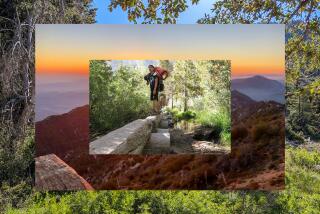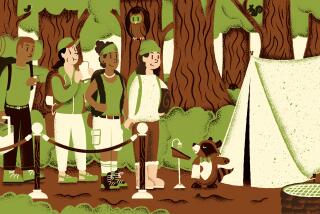Staking Out the Family Tent
In a society where everything old will someday be new again--from bowling to bell-bottoms--car camping is no exception.
Loading the kids into the station wagon for that summer tour of the Grand Canyon or Yosemite is an all-American vacation classic. It’s coming back, but in this case the main reason isn’t necessarily nostalgia.
“It’s the economy. People have less money to go on trips,” said Beth Sherrill, a supervisor at REI in Santa Ana.
Outdoor specialty shops such as REI, Adventure 16 in Costa Mesa and the North Face in Costa Mesa used to turn up their nose at car campers as they catered to more “serious” adventurers, but now they are finding there is a market for high-quality tents big enough for a family.
Tight budgets aren’t the only reason for the return to car camping. People looking for a family vacation are also more environmentally aware and more sports-oriented than in the past, Sherrill says, and more are opting for active outdoor vacations.
Also, says Todd Frabota of Adventure 16, people who used to backpack in the ‘70s now have kids of their own and want to share their love of wilderness with their offspring.
Although the list of possible camping accouterments is long, a tent is the biggest purchase and potentially the most important.
Shopping for a family-size camping tent can be a confusing business. Most large tents look similar on a superficial level, but their performance in the campsite can vary enough to spell the difference between a successful trip and a disaster.
First, it’s important to note how tents have changed over the years. Gone are the Army-green canvas monstrosities of decades past, with their familiar but musty smell. Tents today are primarily nylon, although some tents use canvas (waterproof but still breathable, preventing condensation) in the roof.
Choice of material isn’t the only area where modern family camping tents borrow from their backpacking cousins. Some of the features worth looking for include a rain fly, which covers the main tent structure in bad weather, waterproof nylon flooring that extends at least a foot above the ground and shock-corded poles (which not only help prevent loss of pole sections, but also reduce frustration over figuring out which which pole goes where).
Some family tents are free-standing, a handy feature when the ground is too hard to drive stakes. At the least, the tent should require no guy lines, only floor stakes.
Because weight is not a major factor in car camping, better family tents use relatively thick aluminum poles that won’t buckle at the first hint of wind. The door and windows should be equipped with zippered closures. Seams should be double-stitched at least (preferably triple-stitched) and waterproofed.
Larger family tents have a floor size ranging from 8 feet by 10 feet to 9 feet by 12 feet (sleeping four to six), and should be tall enough to stand in. With good shopping, it’s possible to find a solid family tent in the $100 to $150 range. There are cheaper tents, but they are not likely to stand up to much abuse and may lack critical features.
Also, some of the best car camping in Southern California is in the deserts, where windstorms can kick up with little notice, so spending a little more on a tent can be a wise investment in the long run.
Outdoor specialty shops are a more expensive place to shop than general sporting goods or discount stores, but that’s at least partly because they carry only the better brands. Also, they are more likely to have a floor model of the tent on display; buying a tent based on the photograph on the box is risky business.
Families who backpack, or are thinking about taking up the sport, might consider buying a family-size backpacking tent that can also be used for car camping.
Good backpacking tents are generally more expensive ($300 and up) and not as roomy (sleeping four in a tight 65 square feet, for instance) as models designed for car camping. But they are also much lighter (10 pounds or less, compared to 25 to 30 pounds for car camping models) and generally built to take harsher weather. With backpacking tents, the load can be divided among family members: One person takes the tent, another the poles.
Finally, there are a few simple maintenance tips that can extend the life of a tent.
First, never store the tent damp, or risk ruining the fabric with mildew. Also, sweep the tent free of loose debris; gravel and dirt can clog and even break the zipper.
More to Read
Sign up for The Wild
We’ll help you find the best places to hike, bike and run, as well as the perfect silent spots for meditation and yoga.
You may occasionally receive promotional content from the Los Angeles Times.






